Two genius methods, from two of the most acclaimed chefs, for how to make the most tender, juicy, richly flavorful Roast Chicken. Both methods require minimal prep time (5-10 minutes) and only 3 ingredients, including the chicken.
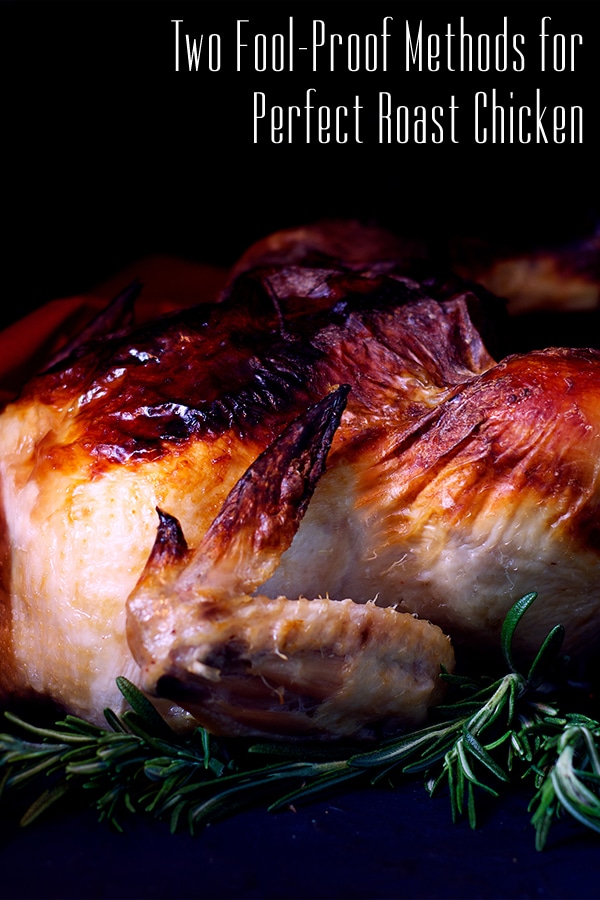
Two Foolproof Methods for Perfect Roast Chicken
There are literally hundreds of recipes for how to roast a whole chicken. A quick google search will turn up high-heat and low-heat methods, a plethora of garlic, lemon, and herb rubs, and a wide variety of sauces and gravy.
Some recipes will tell you to slather the bird in butter and others will urge you not to. You can stuff herbs under the skin and fill the cavity filled with lemons or onions. Some recipes will tell you to place the chicken breast side up in the pan and others will insist you set it breast side down.
Preheat the pan, cook the chicken in a skillet, cook the chicken in the top/bottom/center of the oven, baste it, don't baste it, soak it in a brine, salt it now, salt it later, truss it, spatchcock it, stuff it... it's truly amazing how many methods we humans have for cooking a simple roast chicken.
The truth is, you can follow most roast chicken recipes and you'll end up with a delicious result. Because, unless you over or under cook your bird, roast chicken is an objectively delicious food that's enjoyed by every meat eater on the planet.
Over the years, I've tried many, many different roast chicken recipes. Out of all of them, I keep coming back to two simple methods because...
- The prep time is minimal (we're talking 5-10 minutes)
- They require only a handful of ingredients (3, including the chicken)
- Most importantly - they consistently produce a tender, juicy, richly flavorful chicken with salty, crispy skin.
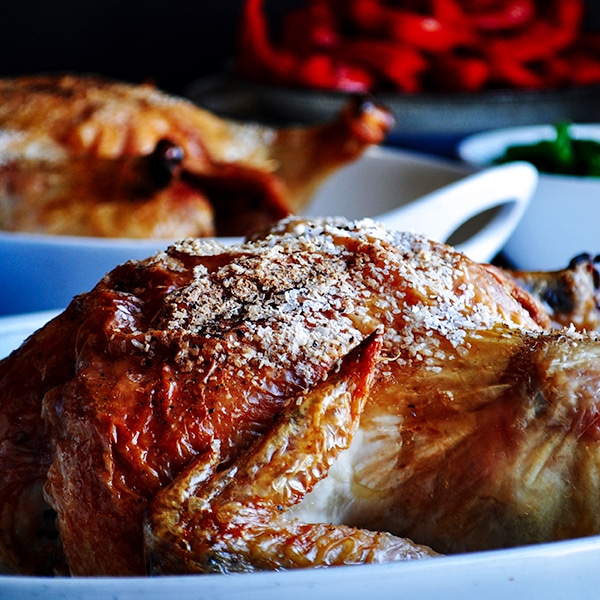
Roast Chicken, Method #1
Thomas Keller's 5-Minute Prep Simple Roast Chicken
Roast Chicken is the very first recipe in Thomas Keller's seminal cookbook, Bouchon. The very fact that Keller, one of the most acclaimed chefs in the world, chose the humble roast chicken as the foundational recipe in one of his cookbooks, speaks to its incredible importance.
Bouchon is a collection of French bistro recipes perfected at Keller's restaurant of the same name. In the book's introduction, he writes,
"The truth of it is, that bistro cooking is my favorite food to eat. Roast chicken and a salad of fresh lettuces with a simple vinaigrette. Frisée salad with crisp, chewy lardons and a poached egg. A dense steak with lemon-herb butter and frites. Ask chefs what their notion of a perfect meal is and nine out of ten will name dishes such as these. These preparations, almost universally appealing, represent what's true and durable in the expanding field of the culinary arts, and are forever satisfying to eat."
Humble, comforting, food like roast chicken will never go out of style, partially because it's delicious, but even more so because the preparation is so very simple.
It would not be an exaggeration to say that I roast a chicken nearly every single week. Sometimes I take the time to soak it in buttermilk for a day or two (Method #2). Other times, I follow Keller's method, which requires only the forethought to have purchased the chicken.
Keller's method requires about 5 minutes of prep work before you put the chicken in the oven and roast it until it's done. Who doesn't have time for that?
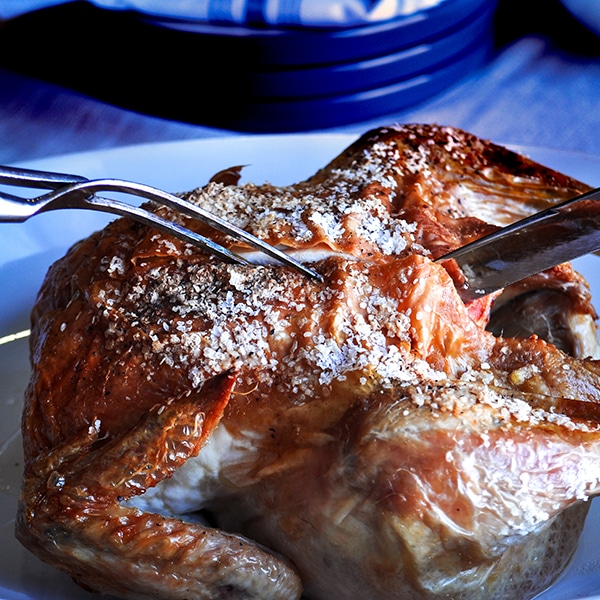
How To Make Thomas Keller's Simple Roast Chicken
(*Modified from Bouchon, by Thomas Keller)
- Preheat your oven to 450 degrees.
- Rinse a 2-4 pound chicken and dry thoroughly with paper towels. It's important to get the chicken as dry as possible if you want that lovely crisp skin. Too much moisture in the oven will cause the chicken to steam, and you'll end up with soft, slightly soggy skin.
- Pour some kosher salt and ground black pepper into the cavity of the chicken and place in a baking dish. (Roasting more than one chicken, at a time? We'll talk about that later.) Sprinkle a generous amount of kosher salt over the outside of the chicken, then sprinkle with pepper. Keller says to "rain the salt over the bird" so the skin is uniformly covered.
- Put the chicken in the oven and let it roast until an instant read thermometer stuck into the thickest part of the thigh registers 165 degrees, about 50-80 minutes (more if your chicken is large or if you're roasting more than one at a time).
- Remove from the oven, baste with the pan juices, and let it rest for 15 minutes on a cutting board.
- Carve and serve.
In Bouchon, Keller mentions that he likes to eat roast chicken slathered in butter, with a side of dijon mustard and a simple green salad. I have eaten roast chicken exactly this way more times than I can count and will never, ever tire of it.
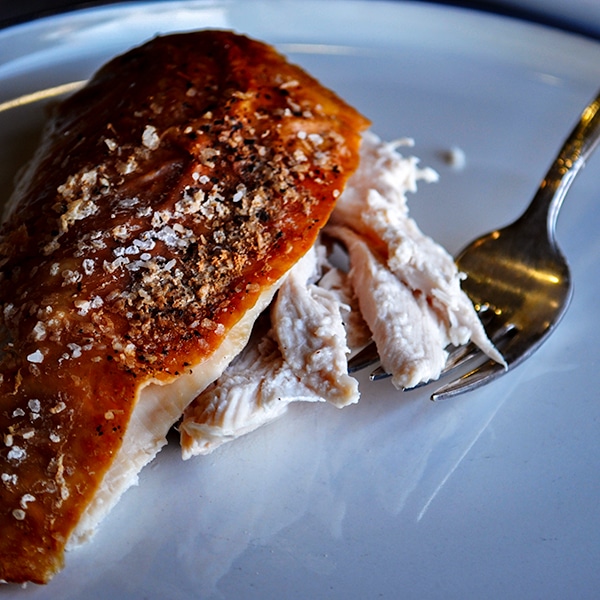
Roast Chicken, Method #2
Samin Nosrat's Buttermilk-Marinated Roast Chicken
How did any of us know how to cook before Samin Nosrat's incredible book, Salt, Fat, Acid, Heat???? I'm serious. Reading her book brought years of cooking together for me in a way that's difficult to overstate.
An obsessive cookbook reader, and somewhat fearless about experimenting in the kitchen, the concepts Nosrat presents in Salt, Fat, Acid, Heat were not a foreign language to me.
And yet... she has a way of condensing thousands of years of cooking wisdom into 200 pages and a short collection of foundational recipes that can quite literally transform you from a good cook to a great one.
Nosrat begins the book with a chapter on salt that, if applied, is enough to take your cooking skills to a whole new level all on its own. She is a tremendous advocate of using salt not to make food salty, but to bring out the flavor in food.
One of the ways she uses salt is to flavor meat and poultry from the inside out. To accomplish this, she salts meat and poultry at least a day or two before cooking it.
Doing so allows plenty of time for the salt to sink into the meat, dispersing throughout the entire cut of meat or bird, flavoring it from the inside out. (There's a lot more to it, which is why Samin wrote a book. Pick it up.)
For Roast Chicken, Samin takes early salting one step further by combining salt with buttermilk and letting the bird soak in the brine for 24 hours. The salt and acid in the buttermilk work together to flavor and tenderize the meat, and prevent liquid from escaping while the bird cooks. As a little bonus, the sugars in the buttermilk caramelize while the chicken cooks, creating a gorgeous dark brown skin.
The end result is a super tender, flavorful, and juicy roast chicken that still requires very little hands-on time.
No buttermilk? No problem! Here are 7 terrific ways for DIY buttermilk, all of which will work perfectly well.
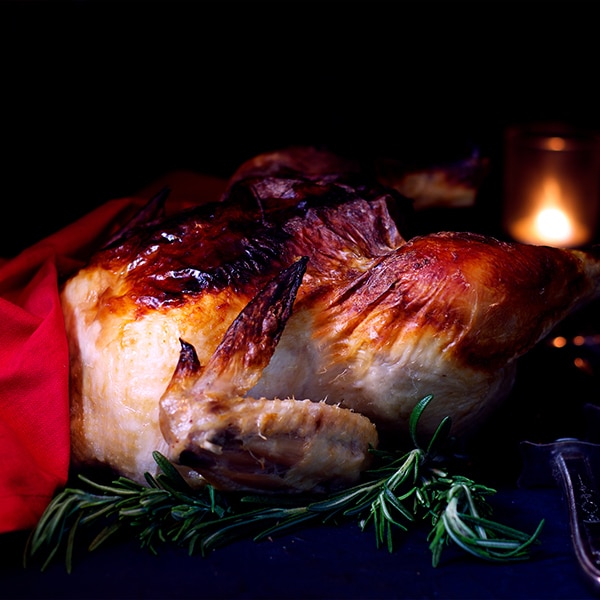
How To Make Samin Nosrat's Buttermilk Marinated Roast Chicken
(*Modified from Salt, Fat, Acid, Heat, by Samin Nosrat)
- About 24 hours before you plan to roast your chicken, sprinkle a 3-4 pound chicken with a generous amount of salt and let it sit at room temperature for 30 minutes.
- Put the chicken in a zip-top bag. Stir 2 tablespoons of kosher salt into 2 cups of buttermilk and then pour the buttermilk over the chicken. Seal the bag and smush it around in there to coat it all over with the buttermilk. (You might want to put it in a second bag at this point just in case the first bag springs a leak.) Put the chicken in the refrigerator
- If you think about it, turn the chicken over every now and then to even out the marinading process. If you forget to do this, don't worry about it. It doesn't make enough of a difference to stress about it.
- An hour before you want to cook your chicken, remove it from the refrigerator and let it rest on the countertop (still in the bag) for an hour. Heat the oven to 425 degrees (F). Remove the chicken from the bag, shaking of excess buttermilk as you do, and put it into a roasting pan.
- Roast the chicken for 20 minutes, then reduce the oven temperature to 400 degrees (F) and cook for another 40-60 minutes (depending on the size of your bird), until the chicken is nicely browned all over and an instant read thermometer stuck into the thickest part of the thigh registers 165 degrees.
- Remove the chicken from the oven and let it rest for 10 minutes. Then carve and serve.
Samin likes to serve roast chicken with Panzanella, and she has a delicious recipe for the bread salad in her book. It's also really great with this Cornbread Salad or Cream Cheese Mashed Potatoes and some Sautéed Veggies.
I am also 100% in love with slathering roast chicken with miso butter which takes less than 5 minutes to prepare and adds a hefty dose of complex, savory, umami-packed flavor.
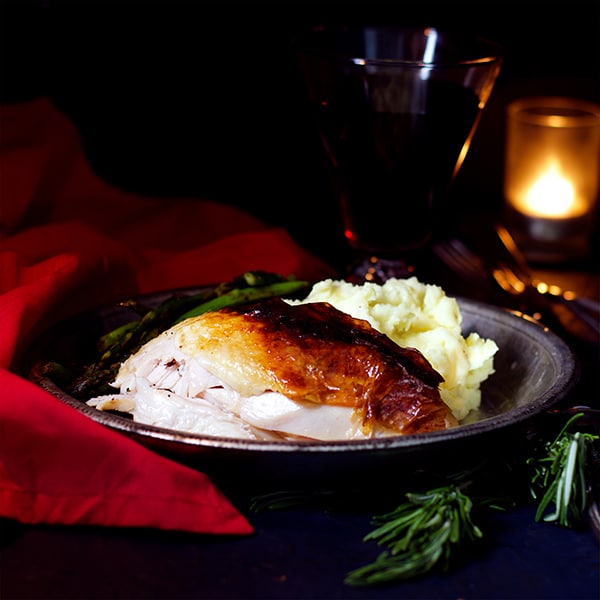
Is it Important to Season Chicken with Kosher Salt?
Kosher salt does not contain any additives, so it tastes cleaner than table salt. It's also inexpensive and dissolves slowly into the chicken.
If you choose to use regular table salt instead, keep in mind that table salt is saltier than kosher salt. If making buttermilk-brined roast chicken, only use 1 tablespoon of table salt in the buttermilk.
Start With High Quality Chicken
The first time I tried Samin's Buttermilk-Brined Chicken, I noticed a difference in the flavor of the cooked bird, but not the level of tenderness. This puzzled me because the acid in the buttermilk should have acted as a fantastic tenderizer.
After experimenting with a few different brands, I confirmed my suspicion: If you don't begin with a high quality bird, you're never going to get a truly high quality roast chicken.
When at all possible, choose an ethically raised chicken that's been fed and treated well.
Is it Important to Truss the Chicken Before Roasting?
Both Keller and Nosrat are advocates of trussing the chicken before roasting... sort of. Keller goes for the fully trussed chicken, while Nosrat simply instructs her readers to clip the tip of the wings off (to prevent burning) and tie the legs together with kitchen twine.
Either of these methods is worth doing. Without at least tying the legs together, the breast will cook faster than the legs and thighs, resulting in dry chicken breast.
Most of the time, I do what Nosrat does and simply clip the tips of the wings and tie the legs together. If you decide to truss your chicken (also really easy to do), here's what to do...
How to Truss a Chicken:
- Lay the chicken breast side up in front of you with the legs pointed toward you.
- Tuck the wing tips back under the bird.
- Cut a 3-foot piece of kitchen twine and slide it under the the chicken between the wings and the thighs.
- Pull both ends of the twine up under the chicken’s wings, stretching the ends away from you on either side of the neck.
- Cross the string at the neck and bring the ends back towards you so that the twine is encircling the outside breast of the chicken and the ends of the string are next to the legs.
- Cross the string again, right in front of the cavity opening, and pull tightly.
- Loop the ends of the string under the legs, then over the top of the legs, crossing the string again and pulling it tight.
- Flip the bird over and tying the strings in a knot around the tail. Snip off the ends of the twine.
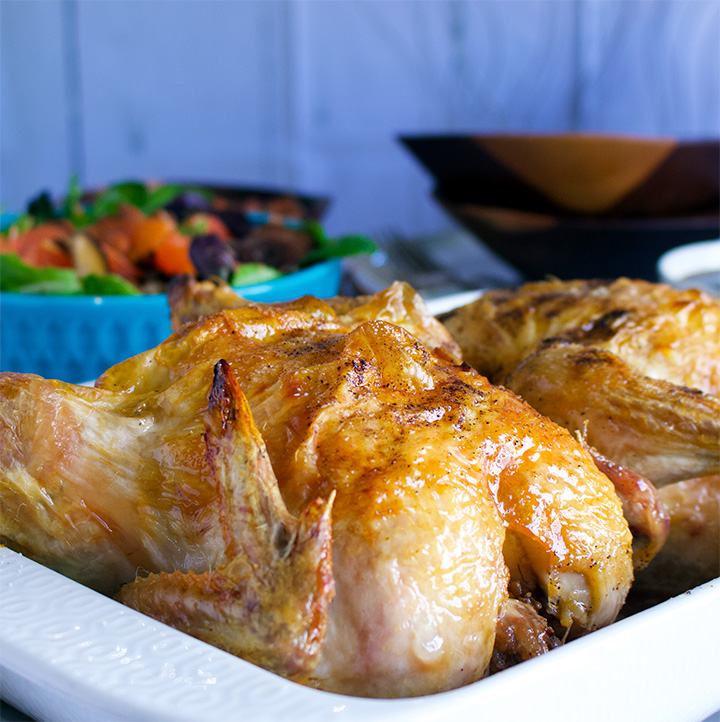
Roast More than One Chicken at a Time
Having extra roast chicken in the refrigerator or freezer, ready to toss onto a salad or layer into a sandwich, or to use as the foundation for a quick dinner, is always a good idea. It takes hardly any more work to roast two or three birds than it does to roast just one, so why not?
There are certainly exceptions to this rule, but I generally make Roast Chicken on a Sunday, roasting one for my family and I to eat that night and at least one or two more in preparation for the rest of the week's meals.
After dinner, I pick the meat from the bones, put the bones from one or two of the birds in the slow cooker, cover them with water, and let it cook on low all night long.
In the morning, I not only have deliciously juicy and flavorful roast chicken meat in the refrigerator, but chicken broth far superior to anything you can purchase at your local market and that cost nothing more than the price of water.
When roasting more than one chicken at a time, it can be useful to put them in their own baking dishes or roasting pans, unless you're working with a very large pan. Essentially, you want to avoid crowding the chickens together into a tight space; rather, leave room for the heat to circulate all around each bird.
Delicious recipes that start with leftover roast chicken
One of the easiest and most delicious ways to use leftover roast chicken is in these street tacos. I like to top them with some fresh pico de Gallo and a drizzle of vegan sour cream.
Equally easy and delicious is this 30-minute chicken soup which can be made with rotisserie chicken or leftover roast chicken.
Here are plenty of other ideas for how to use leftover roast chicken...
- Chicken Lettuce Wraps
- Dutch Oven Pot Pie
- Creamy Chicken Chili (having fully roasted chicken will shave 30 minutes off the recipe)
- Cheese Enchilada Casserole
- Crispy Corn Tortilla Quesadillas
- Roast Chicken Salad with Lemon Vinaigrette and Sesame Crunch
- Creamy Chicken Noodle Soup with Garlic and Mushrooms
- 20-Minute Garlic Chipotle Pasta with Chicken
- Chili Chicken Nachos with Chimichurri Sauce (Skip all the recipe instructions about cooking the chicken.)
- Open Face Chicken Salad Sandwiches
- Chicken Chopped Salad
- Enchiladas Verdes (Green Enchiladas)
- Creamy Chicken and Rice
- Chicken Tortilla Soup
- Chicken Salad Niçoise
Useful Tools and Resources for Roasting Chicken:
- Bouchon by Thomas Keller
- Salt, Fat, Acid, Heat, by Samin Nosrat
- Crock Pot Slow Cooker (for making simple homemade chicken broth)
- Roasting Pan
If you give this recipe a try, let me know! Leave a comment, rate it, or take a picture and tag it #alittleandalot on Instagram.
📖 Recipe
How to Roast Chicken {2 Fool Proof Methods}

Ingredients
(*Modified from Bouchon, by Thomas Keller)
- One 3-4 pound chicken
- Kosher salt and ground black pepper
(*Modified from Salt, Fat, Acid, Heat, by Samin Nosrat)
- One 3-4 pound chicken
- Kosher salt
- 2 cups buttermilk
Instructions
Method #1:
- Preheat your oven to 450 degrees.
- Rinse a 3-4 pound chicken and dry thoroughly with paper towels. It's important to get the chicken as dry as possible if you want that lovely crisp skin. Too much moisture in the oven will cause the chicken to steam, and you'll end up with soft, slightly soggy skin.
- Pour some kosher salt and ground black pepper into the cavity of the chicken and place in a baking dish. Sprinkle a generous amount of kosher salt over the outside of the chicken, then sprinkle with pepper. Rain the salt over the bird so the skin is uniformly covered.
- Put the chicken in the oven and let it roast until an instant read thermometer stuck into the thickest part of the thigh registers 165 degrees, about 50-80 minutes (more if your chicken is large or if you're roasting more than one at a time).
- Remove from the oven, baste with the pan juices, and let it rest for 15 minutes on a cutting board.
- Carve and serve.
Method #2: Buttermilk Marinated Roast Chicken
- About 24 hours before you plan to roast your chicken, sprinkle a 3-4 pound chicken with a generous amount of salt and let it sit at room temperature for 30 minutes.
- Put the chicken in a zip-top bag. Stir 2 tablespoons of kosher salt into 2 cups of buttermilk and then pour the buttermilk over the chicken. Seal the bag and smush it around in there to coat it all over with the buttermilk. (You might want to put it in a second bag at this point just in case the first bag springs a leak.) Put the chicken in the refrigerator.
- If you think about it, turn the chicken over every now and then to even out the marinading process. If you forget to do this, don't worry about it. It doesn't make enough of a difference to stress about it.
- An hour before you want to cook your chicken, remove it from the refrigerator and let it rest on the countertop (still in the bag) for an hour. Heat the oven to 425 degrees (F). Remove the chicken from the bag, shaking of excess buttermilk as you do, and put it into a roasting pan.
- Roast the chicken for 20 minutes, then reduce the oven temperature to 400 degrees (F) and cook for another 40-60 minutes (depending on the size of your bird), until the chicken is nicely browned all over and an instant read thermometer stuck into the thickest part of the thigh registers 165 degrees.
- Remove the chicken from the oven and let it rest for 10 minutes. Then carve and serve.
Notes
No buttermilk? No problem! Here are several great ways to make a buttermilk substitute.
Nutrition Information:
Amount Per Serving: Calories: 0Total Fat: 0gSaturated Fat: 0gTrans Fat: 0gUnsaturated Fat: 0gCholesterol: 0mgSodium: 0mgCarbohydrates: 0gFiber: 0gSugar: 0gProtein: 0g
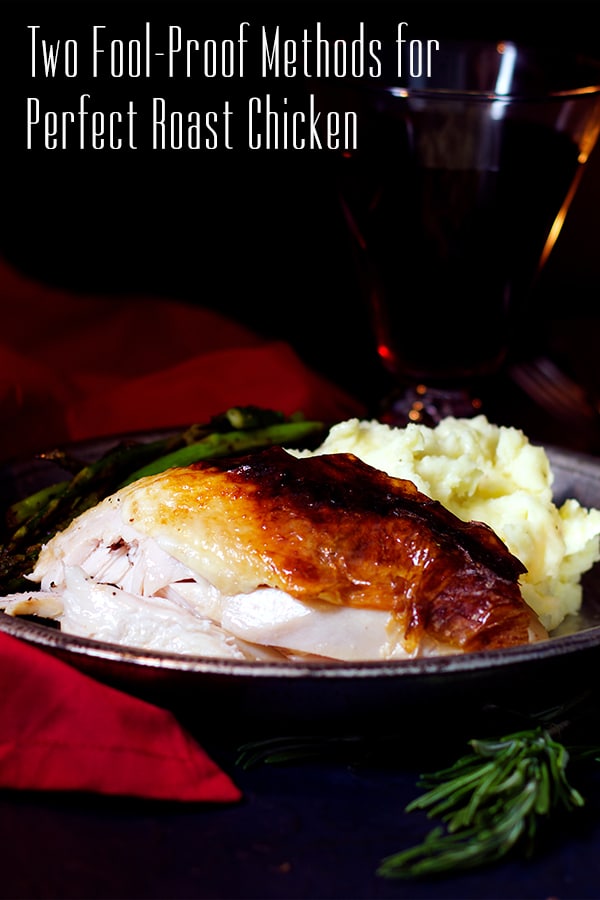

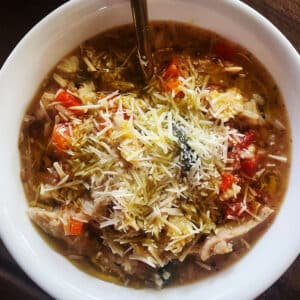
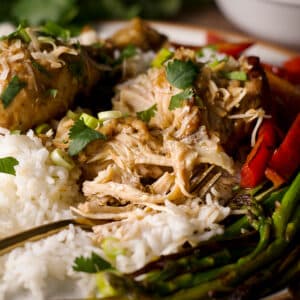
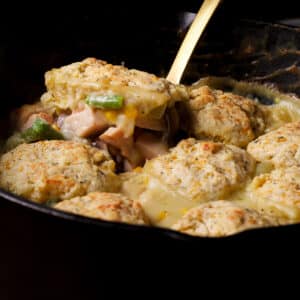
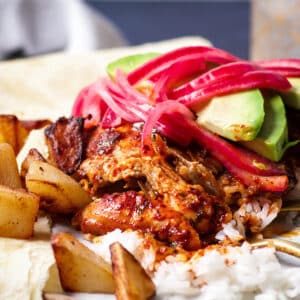
Chris David says
Made this for lunch, absolutely delicious! Simple and easy to bake. Will be sharing and keeping. Thank you!
RebeccaBlackwell says
So happy to hear you liked this recipe Chris. Thank you so much for taking the time to leave a comment! I truly appreciate it! xo
Connie A says
Just tried the "Buttermilk Marinated Roast Chicken" recipe. It was so tender and moist! We usually like the dark meat the best, but the white meat was just as tasty. I'm not sure what marinating the chicken in buttermilk does, but it was the best roasted chicken we have ever had.
RebeccaBlackwell says
I'm so happy to hear that this recipe worked out so well for you! Soaking chicken in buttermilk really is magic. The acid in the buttermilk tenderizes the chicken, and when combined with salt, flavors the meat from the inside out. It's my favorite way to prepare a bird for roasting. Thank you so much for taking the time to leave a comment for me. I truly appreciate it! xo
Melanie says
My first attempt at a roast chicken was a disaster!! But, then I found your blog and decided to try again. I made the Cajun sheet pan meal last week and lived the flavor from the rub. Idea time!!! I marinated the chicken in buttermilk but before roasting I rubbed some of the Cajun rub under the skin and in the cavity of the chicken. It was absolutely amazing!!! Best roast chicken ever!!! Thank you so much for such great recipes and wonderful blog!
RebeccaBlackwell says
Hi Melanie! Using Cajun rub on roast chicken sounds absolutely delicious! As many times as I've made roast chicken over the years (hundreds!), I've never thought to use a cajun rub. I can't believe I never thought of it. I'm totally going to do that this week. Thanks for the great idea, and thanks even more for taking the time to leave a comment for me. I appreciate it so much! xo
Lynn Southard says
Love, love, love, love my chicken. I set out to do the buttermilk but couldn't find any at the store and was too lazy to go to another store. I knew I had Kefir (the champagne of dairy products) in my fridge so I substituted that thinking it would be a happy accident or a miserable failure. Since I was deviating from the buttermilk, I decided to also deviate and smoke the bird on the Traeger grill rather than an oven roast. Low and behold, it worked. Your blog has been an inspiration to me! Last night I did the Cuban Chicken and next week I'm going to do the tahini chicken. Hugs and peace.
RebeccaBlackwell says
I must go find some Kefir now and try it! And, I can imagine that "roast" chicken is even better when smoked. I don't have a smoker, but I'm soooo close to pulling the trigger and getting one. The idea of smoking chicken rather than roasting it in the oven might have just pushed that decision over the edge. 🙂 Thank you so much for taking the time to leave a comment! xoxo
Jagruti Dhanecha says
I too love quick and easy method recipes, beautifully done chicken and very informative post.
Shannon says
The simplicity of these two methods is just so wonderful and I love your idea of cooking two chickens at once so that the second can be used for salads or other meals throughout the week. Roast chicken is really such a tasty addition to so many meals.
RebeccaBlackwell says
Thank you Shannon! Having some roast chicken hanging out in the refrigerator is always a good idea. 🙂
Anne Lawton says
Roasted chicken is pure comfort food as far as I am concerned. Thanks for all of these tips - hoping my next roast chicken is perfect!
Karyl Henry says
I love roasted chicken, but I never think of making them myself. These both sound fabulous, but the Bouchon method with the slathered butter is calling my name just a little bit more! I'll definitely have to give both of these a try
Eva says
First of all, thank you for this descriptive post that teaches two methods to roast chicken. Second of all, thank you for the book recommendations. I so belong to the internet generation that I always overlook cookbooks but I may change my mind and listen to your book advice.
Anna says
Love the simple method, as it's just so easy! but I MUST try the buttermilk marinade, as I've never had that before! Sounds and looks delicious, thanks for sharing!
RebeccaBlackwell says
Thanks Anna! The buttermilk marinade really does make a remarkable difference. I've started soaking chicken in buttermilk for all sorts of dishes - not just whole roast chicken. It just makes it so tender. On a totally different note, AnnaBanana, my husband and I have a daughter named Anne, that we've called Annie-Bananie pretty much since the day she was born. 🙂
Dominique | Perchance to Cook says
Oh thank you for posting this! I have never tried either method to roast chicken and I am absolutely going to now. I'm going to start with the 5 minute prep one.. the faster and less prep the better!
RebeccaBlackwell says
Hi Dominique! You'll love Thomas Keller's method for roast chicken. I mean... you really can't go wrong with anything Thomas Keller suggests though, can you? xo
Aleta says
This is such a great post! I LOVE all your tips and tricks. It's going to make roasting a chicken easy peasy from here on out 🙂
RebeccaBlackwell says
Thank you Aleta! I really appreciate your taking the time to leave this comment!
Kylie | Midwest Foodie says
My husband is always asking me to make chicken and this recipe is definitely going into our meal rotation! Buttermilk is THE BEST marinade ever!! Thanks for sharing a great recipe!
RebeccaBlackwell says
Isn't buttermilk just pure magic??? You think it's just a plain, boring ingredient, but it's actually the biggest superhero in the refrigerator. I hope you, and your husband, enjoy either of these methods. Thanks so much for leaving a comment to let me know you were here! xo
Danielle says
I love when one recipe shows two different ways of making the dish. And when they are both easy, quick and delicious, the recipe can't get any better. I am happy I have found yours! 🙂
RebeccaBlackwell says
Hi Danielle! Thank you so much! These days, I almost always have at least one chicken hanging out in the refrigerator in it's little buttermilk bath, just waiting to be tossed into the oven. God bless Samin for that life changing tip. 🙂 xo
Veena Azmanov says
The Glaze to the chicken is amazing and the flavors are perfect and the chicken looks mouth melting too. A must try option for sure.
RebeccaBlackwell says
Thank you so much Veena! Samin Nosrat is a genius for teaching us all to soak our chickens in buttermilk. I appreciate your taking the time to leave a comment! xo
Cate says
Thanks Rebecca for the benefit of 2 cookbooks worth of information on roasting in one post! Can you think of a reason the buttermilk and salt brine (obviously with increased amounts of salt and buttermilk) wouldn’t be equally good for a turkey? I’ve got a good one in the freezer and thought maybe I could try this technique for roasting turkey.
RebeccaBlackwell says
Yeeeessss! I think it would be perfect for turkey. Possibly even better than with chicken, because I *think* the buttermilk would round out some of that gamey flavor you sometimes get with turkey. I'd be sure to leave it in the buttermilk brine for at least 2 days. If you try it, will you let me know how it works? I've given up on making turkey on Thanksgiving in lieu of pork carnitas.... but, depending on how much of a difference you feel the buttermilk marinade makes with your turkey, I might have to try it this year. xo